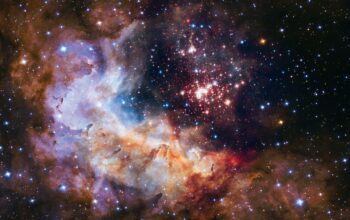Understanding the interplay of nuclear forces between nucleons is fundamental to the field of nuclear physics. This study not only reveals the intricate dynamics of subatomic particles but also poses several contemplative questions. For instance, have you ever pondered how these tiny constituents of matter can bind together to form the nucleus of an atom despite the repulsive forces at play? This article aims to delve into the complexities of nuclear forces, exploring their mechanisms, implications, and the challenges that arise in our comprehension of these fundamental interactions.
The nucleus of an atom consists primarily of protons and neutrons, collectively referred to as nucleons. Central to the stability and integrity of the atomic nucleus is the nuclear force, which is key to overcoming the electromagnetic repulsion between positively charged protons. At a glance, one might conceive of these forces as simple interactions; however, the nature of nuclear forces is exquisitely complex and multifaceted.
Nuclear forces operate predominantly via the strong interaction, one of the four fundamental forces of nature. This force is not only the strongest of them all, but it also acts at very short ranges, approximately on the order of a femtometer (10-15 meters). To conceptualize this, consider the analogy of a magnet: while magnets can exert a force over a distance, the strong interaction requires nucleons to be in close proximity to one another, facilitating a uniquely intimate bond.
This strong interaction is mediated by particles known as gluons, the exchange particles or ‘force carriers’ of the strong force. Gluons facilitate the connection between quarks—thereby forming protons and neutrons—through their unique property of color charge. This is analogous to electric charge in electromagnetism, but with quantifiable distinctions. Unlike electric charges that can repel at distance, color charges maintain a property of ‘confinement,’ meaning quarks are never found in isolation; they are perpetually bound within their respective nucleons.
Moreover, the strong nuclear force displays a remarkable characteristic known as saturation. This implies that when nucleons are densely packed within a nucleus, the force only acts optimally up to a certain limit. Beyond that limit, increasing the number of nucleons does not significantly enhance the attractive force. This phenomenon introduces complexities in nuclear interactions, particularly in larger nuclei, where additional nucleons do not proportionately increase binding energy. Instead, they can lead to instability—highlighting a fascinating paradox in nucleon interactions.
Another essential aspect of nuclear forces is their short-range nature. The attractive strong force is effective only within a minuscule range, but once nucleons are separated beyond approximately two femtometers, electromagnetic repulsion takes over. This transition between attractive and repulsive forces invites an important question: How does this delicate balance manage to prevent spontaneous disintegration of nuclei? The answer lies in the residual strong force, which acts similarly to van der Waals forces in molecular chemistry. This residual force is weaker than the primary strong force but plays a pivotal role in binding nucleons across various energies and distances.
An equally significant consideration is the role of spin and quantum mechanics in nuclear forces. Nucleons possess intrinsic angular momentum, or spin, which engenders magnetic moments. These moments can contribute to the interaction strength and character, with specific orientations leading to varying nuclear outcomes. For example, in certain configurations, like in some isotopes of helium-4, paired nucleons exhibit a phenomenon known as Cooper pairing, where differences in spin lead to enhanced binding through an indirect attractive force. The interplay between quantum mechanics and nuclear forces frequently births unexpected results that challenge conventional understanding.
In exploring the comprehensive nature of nuclear interactions, one might encounter models and theories attempting to explain these phenomena. The most prominent among them is the Yukawa potential, which elucidates the forces at play using a well-defined potential model based on mesonic exchange between nucleons. However, while the Yukawa framework provides a clearer understanding, it also unveils limitations in describing the full complexities associated with nuclear behavior in more massive systems or in the context of certain nuclear reactions.
A fascinating challenge arises when considering the instability of larger nuclei. As the number of nucleons increases, the nucleus faces an uphill battle against instability, often resulting in radioactive decay or fission. This leads to a lesser-known aspect of nuclear forces—the role of weak interactions. It would be remiss not to acknowledge how weak forces can facilitate processes like beta decay, where a neutron transforms into a proton (or vice versa), subtly affecting the nuclear landscape despite operating on a different plane than the strong force.
At the intersection of theoretical investigation and experimental observation lies the field of nuclear astrophysics. The formation of elements within stars through nucleosynthesis processes seeks to balance the formidable forces at play. When reviewing the life cycle of stars, from the nucleosynthesis during hydrogen burning to the explosive supernova events, one cannot help but marvel at how gravitational forces interact with nuclear forces to shape the cosmos.
In summary, the phenomenon of nuclear forces as they operate between nucleons stands as one of the pivotal studies within theoretical and experimental physics. The intricacies of these interactions offer insights not only into the structure of matter itself but also illuminate the underlying principles governing our universe. As research continues to unfold, the questions surrounding nuclear forces remain not only a challenge but also an invitation to further explore the qualitative nuances of the atomic world.












